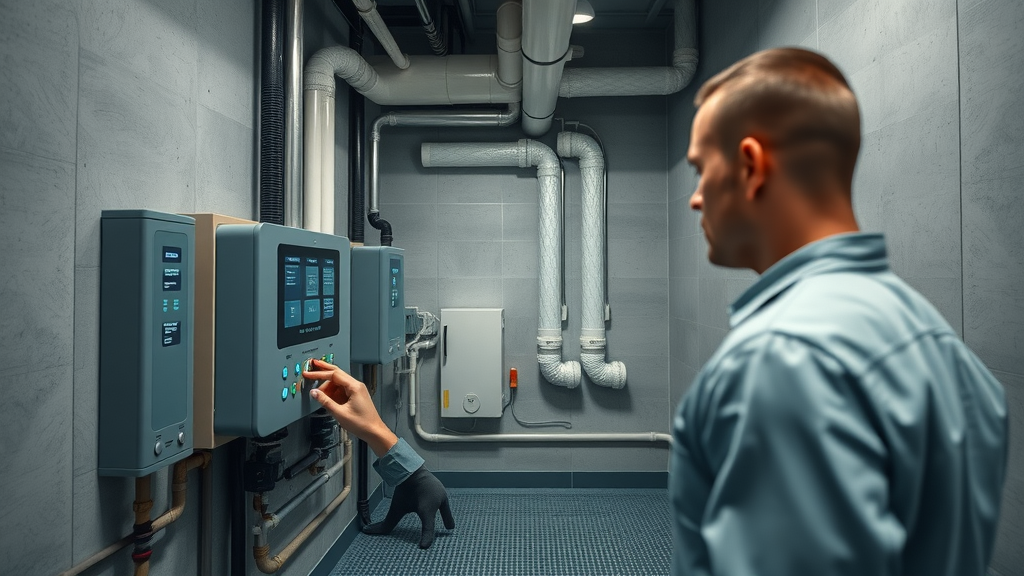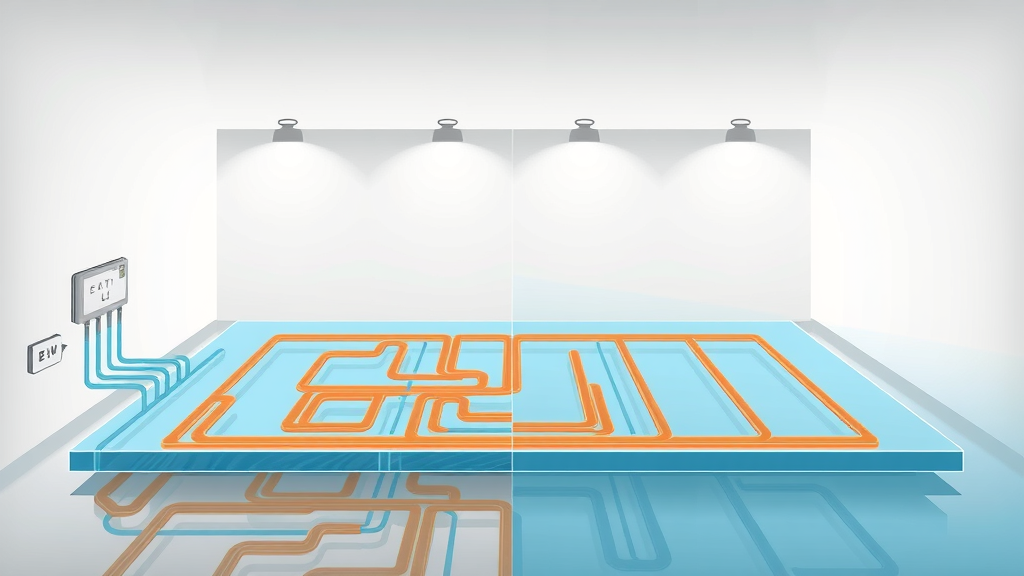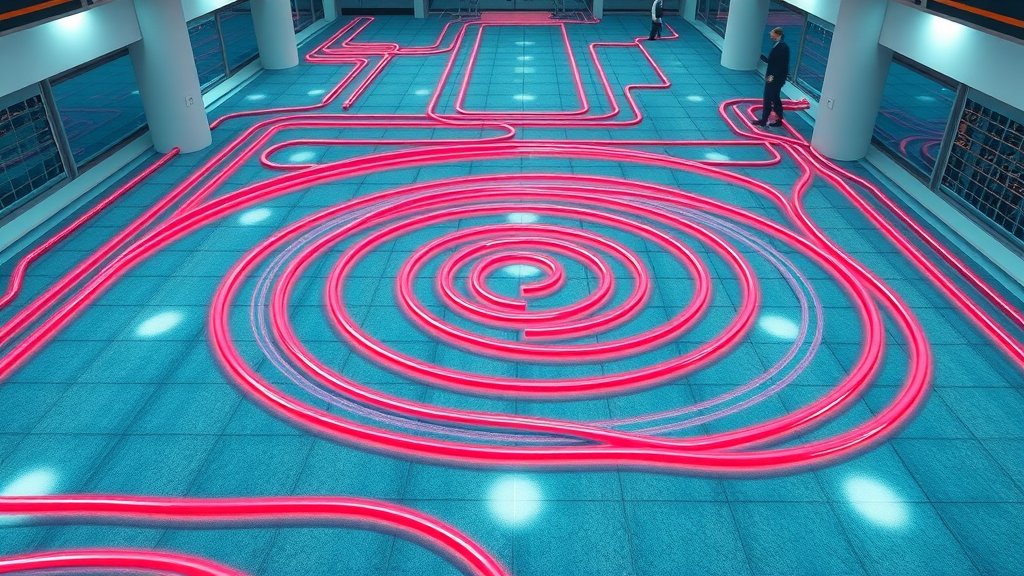Did you know that commercial underfloor heating systems can lower energy consumption by up to 15% compared to traditional heating? If energy bills are squeezing your bottom line or your workspace struggles to stay evenly comfortable, there’s a smarter way to heat large buildings. Modern floor heating isn’t just about warmth; it’s a strategic investment in efficiency, employee comfort, and the future of sustainable workplaces. Whether you manage an office, retail park, or industrial warehouse, underfloor heating could be the upgrade your property needs to save energy, cut costs, and improve working conditions—while keeping you ahead of tightening sustainability targets.

What You'll Learn About Commercial Underfloor Heating Systems
- Essential features of modern commercial underfloor heating systems
- How commercial underfloor heating systems outperform traditional heating systems
- Cost-efficiency and energy-saving aspects of floor heating
- Comparison of electric underfloor heating and water underfloor systems
- Guidance on selecting the best underfloor heating system for your building
- Expert insight into the installation process and regulatory requirements
The Surprising Impact of Commercial Underfloor Heating Systems on Energy Use
Many commercial property owners are amazed at the difference underfloor heating systems make in both energy costs and daily operations. Unlike conventional radiators that create hot spots near vents or walls, commercial underfloor heating systems deliver radiant heat evenly across large floor spaces. This not only increases occupant comfort, especially in high-ceiling l buildings, but also allows thermostats to be set lower, driving energy savings without sacrificing warmth.
Research shows that radiant floor heating operates more efficiently—lowering the need for high boiler temperatures or constant fan output in ducted air systems. According to independent studies, this approach can reduce energy consumption, slash annual bills, and support sustainability goals. Commercial buildings like retail parks, open-plan offices, and showrooms report a notable drop in gas and electricity use after making the switch from traditional heating systems.
"According to Carbon Trust, underfloor heating can cut energy consumption by up to 15% in commercial buildings compared to conventional systems."

Commercial Underfloor Heating Systems: Features, Types & Benefits
Defining Commercial Underfloor Heating Systems and Floor Heating Fundamentals
At their core, commercial underfloor heating systems transfer warmth through pipes or heating cables beneath the finished floor, offering a gentle, even heat source. Unlike bulky radiators or forced-air ducts, these floor heating systems remain out of view, maximising usable space and supporting cleaner architectural lines. There are two main floor heating technologies: electric underfloor heating (using heating mats or cables) and water underfloor heating (circulating hot water through underfloor pipes).
Modern heating and cooling solutions are tailored for the diverse needs of commercial properties, from offices and hotels to industrial buildings and retail spaces. Floor heating offers a versatile heating solution, easily integrated into new build projects but also adaptable for retrofitting in existing l buildings. By acting as a vast radiant panel, underfloor heating enhances occupant comfort, improves air quality, and reduces the recirculation of dust compared to forced-air systems.
Electric Underfloor Heating vs Water Underfloor Heating Systems
When it comes to choosing a commercial underfloor heating system, the two leading technologies each have specific strengths. Electric underfloor heating solutions use slim, fast-response heating mats or cables, making them ideal for projects with limited floor height or where quick installation is crucial. Meanwhile, water underfloor heating—sometimes called hydronic systems—features robust piping loops and is commonly fed by boilers or heat pumps, delivering low running costs over larger spaces.
Both system types are energy efficient compared to radiators, but water underfloor heating stands out for compatibility with heat pumps (including air source and ground source heat pumps) and sustainable heating solutions. Electric underfloor systems, on the other hand, tend to have quicker response times but lower overall efficiency in large-scale commercial settings. Carefully weighing install costs, space constraints, and your preferred energy supply is key.
| Feature | Electric Underfloor Heating | Water (Hydronic) Underfloor Heating |
|---|---|---|
| Install Cost | Lower (especially for small areas), minimal floor build-up | Higher initial cost (specialist installation, pipework, and manifolds required) |
| Running Cost | Higher (uses mains electricity, less efficient in large spaces) | Lower (especially when paired with gas boilers or heat pumps) |
| Response Time | Fast (heats up quickly) | Slightly slower (larger thermal mass to warm up) |
| Longevity | 15–20 years with standard maintenance | 30+ years with high-quality installation |
| Ideal Building Types | Retrofits, small offices, high-end bathrooms | New build projects, large open spaces, warehouses, public buildings |
| Heating & Cooling Compatibility | Mostly for heating only | Can provide heating and cooling when used with heat pumps |
| Heat Pump Integration | Limited | Excellent compatibility with all types of heat pumps |

Key Benefits of Installing Floor Heating in Commercial Environments
- Superior energy efficiency and lower running costs – Underfloor heating operates at lower temperatures compared to radiators, translating to savings on utility bills for commercial buildings over time.
- Even heat distribution across large floor spaces – Floor heating provides consistent warmth without cold spots, particularly effective in open-plan and high-ceilinged l buildings.
- Improved air quality with no dust circulation – Unlike forced-air systems, underfloor heating doesn’t stir up dust or allergens, supporting a healthier workplace environment.
- Design flexibility — no wall-mounted radiators required – Architects and facility managers enjoy greater freedom in commercial interior design and valuable wall space is freed up.
- Compatibility with low-carbon heat pump sources – Futureproof your commercial building by pairing underfloor systems with an air source heat pump or ground source heat pump for optimal heating and cooling efficiency.
Choosing the Right Commercial Underfloor Heating System for Your Building
Assessing Building Type and Heating Solution Requirements
Every commercial property is unique. Factors such as the size and use of the l building, floor construction, ceiling heights, and insulation levels all influence your floor heating system selection. Offices or retail parks may prioritise quick heat-up times and minimal disruption, while warehouses or industrial buildings often require robust, long-life water underfloor heating. Consider your long-term occupancy plans—new build projects can incorporate underfloor heating into their design service, while retrofits must work within existing structures.
Working with a specialist like Peak Underfloor Heating Ltd ensures you benefit from a bespoke design service tailored to your needs, whether you require a wide range of underfloor heating mats, cables, or extensive hydronic networks. A supply and install partner who understands compliance, building regulations, and the nuances of heat pump integration will ensure your chosen system operates efficiently throughout its lifespan.
Comparing Floor Heating Systems for Offices, Warehouses, and Public Buildings
Floor heating systems are adaptable to a wide range of settings—each with different performance and budget priorities. Office spaces often benefit from electric underfloor heating mats for speed and ease, while large commercial buildings, like warehouses or distribution centers, might opt for water underfloor heating pipes due to cost efficiency over big floor areas.
Public buildings, hospitals, and leisure centres often prefer hydronic systems because of their compatibility with sustainable heat sources like air source heat pumps. Underfloor solutions can be fine-tuned to meet high-level comfort standards, maintain thermal zoning, and support energy-efficient heating and cooling. Engaging an experienced underfloor heating system supplier guarantees a tailored recommendation based on your exact application.

Integrating Heat Pumps with Underfloor Heating for Maximum Efficiency
For property owners looking to maximise the benefits of commercial underfloor heating systems, integrating with a heat pump—particularly an air source heat pump or ground source heat pump—delivers substantial energy gains. Because underfloor systems work best at lower flow temperatures (typically around 35-45°C, compared to 65-80°C for radiators), heat pumps can operate at their optimal efficiency.
This synergy unlocks the full potential of low-carbon heating and cooling for large spaces, significantly reducing operational costs and carbon footprint. Whether you are managing a new build or upgrading an existing l building, pairing underfloor heating with renewable energy sources brings your energy strategy in line with future government regulations and green building certifications.
Design Considerations: Underfloor Heating Layouts, Costs, and Installation
Optimal Underfloor Heating System Layouts for Energy Efficiency
The layout of your commercial underfloor heating pipes or cables is critical for comfort and operating costs. Popular configurations include spiral and serpentine patterns, each designed to maximise even heat distribution. For instance, spiral layouts are ideal for large, open-plan commercial areas—reducing surface temperature variation and ensuring radiant heat reaches all corners effectively.
A well-designed system uses strategically sized underfloor heating pipes or electric mats to match your building’s load requirements. Modern control systems allow for smart zoning, allowing facility managers to adjust heat on a room-by-room basis, ensuring occupied areas are comfortable while unused zones remain energy efficient. With expert design and commissioning, underfloor heating layouts can help your business achieve significant savings over the life of your building.

Project Cost Table: Underfloor Heating Cost Per m² by System Type
| System Type | Supply Only (£/m²) | Supply & Install (£/m²) | Typical Application |
|---|---|---|---|
| Electric Underfloor Heating Mat | £30–£50 | £60–£90 | Small offices, retrofits, bathrooms |
| Electric Heating Cable | £35–£55 | £70–£95 | Complex floor plans, high-traffic areas |
| Water Underfloor Heating (Screed) | £35–£55 | £80–£120 | New build offices, warehouses, large public spaces |
| Water Underfloor Heating (Low Profile) | £45–£70 | £100–£140 | Upgrades, refurbishments, listed buildings |
Prices are indicative and depend on the project scale, construction type, and specification.
Installation Timelines, Disruption, and Building Regulation Essentials
Installation of commercial underfloor heating systems can align closely with typical construction or refurbishment schedules. Electric systems may be installed in as little as a day for smaller office spaces, while hydronic (water underfloor) installations can take longer, especially for large new build or industrial buildings. Projects are typically staged—starting with floor preparations, followed by pipe/cable laying, screeding or dry fitting, and then system commissioning by certified engineers.
Minimising business disruption is a major priority, so partnering with experienced supply and install professionals ensures efficient project delivery. Compliance with building regulations is mandatory: underfloor heating systems in the UK must meet Building Regulations Part L for energy efficiency and be installed according to manufacturer guidance. Engaging a design and install service provider, such as Peak Underfloor Heating Ltd, ensures that regulations are fully met, documentation is in place, and warranty cover is preserved for peace of mind.
Animated Walkthrough: Imagine a smooth installation process from initial planning, expert floor preparation, to safe and thorough commissioning—completed by skilled professionals in full safety gear. A well-executed installation not only delivers energy efficiency but ensures reliable performance for decades.
Real-World Success: Case Studies of Commercial Heating and Cooling Projects
Seeing is believing—numerous commercial property owners across the UK have transformed their operational costs and workplace wellbeing by embracing modern underfloor heating. For example, a Midlands retail park retrofitted their main block with a water underfloor heating system paired with a source heat pump. They reported not only a marked improvement in customer comfort but also a significant cost saving.
"Our new underfloor heating system reduced our energy bills by 20% and improved comfort for our team and customers. – Operations Director, Midlands Retail Park"
Other success stories include office complexes that replaced dated radiators with electric underfloor heating mats, drastically reducing maintenance requirements and eliminating cold drafts caused by forced air heating systems. Industrial buildings cite improved temperature uniformity and cleaner working environments as major advantages—especially important for facilities handling sensitive electronics, pharmaceuticals, or food production.

People Also Ask: Your Top Questions on Commercial Underfloor Heating Systems
What is the downside of underfloor heating?
While commercial underfloor heating systems offer energy savings and comfort, some downsides exist. Installation costs can be higher than for standard radiators, especially in retrofit projects where floors must be lifted. Slow initial heat-up times, especially for water-based systems, may require smart control strategies. In some cases, maintenance or repair can be more involved, as the system is installed out of sight beneath the floor. However, these factors are typically outweighed by long-term efficiency and savings, especially when properly designed and installed.
Do I need building regulations for underfloor heating?
Yes, installing underfloor heating systems in UK commercial buildings requires compliance with Building Regulations—specifically Part L, which governs energy efficiency. The system should be designed and commissioned by professionals who understand both product specifications and regulatory requirements. Using a certified supply and install partner ensures you receive correct documentation, system safety, and access to manufacturer warranties.
How much does underfloor heating cost per m²?
Typical supply-only prices for commercial underfloor heating range from £30 to £70 per m² for electric systems and £35 to £70 per m² for water systems. With full installation, costs can vary between £60–£140 per m² depending on system choice, scale, and project complexity. Cost efficiency improves with larger projects and smart system design—contacting a specialist and getting a detailed quote is always recommended for precise budgeting.
What is the most efficient underfloor heating layout?
The most efficient layout for underfloor heating in commercial spaces is typically the spiral pattern, which ensures even radiant heat across the space and minimises cold spots. This design suits large open areas found in warehouses and offices. Zoning controls further enhance efficiency by targeting heat only where and when it's needed, reducing waste and saving on energy costs.
Frequently Asked Questions about Commercial Underfloor Heating Systems
-
How long do commercial underfloor heating systems last?
Well-installed systems can last 30+ years, especially hydronic (water) systems. As long as you follow manufacturer servicing recommendations, long-term reliability is excellent. -
Are commercial underfloor heating systems compatible with renewable energy?
Yes, underfloor heating pairs perfectly with modern heat pumps, including air source and ground source, making it highly suitable for buildings targeting low-carbon operation. -
Can underfloor heating systems be retrofitted into existing commercial buildings?
Absolutely. There are specialist low-profile water underfloor systems and slim electric mats designed for retrofitting with minimal height gain and disruption to business activities. -
What maintenance do commercial underfloor heating systems require?
Floor heating requires minimal routine maintenance. Annual checks by professionals are advised to keep pumps, thermostats, and controls operating at peak performance.
Key Takeaways: Why Install Commercial Underfloor Heating Systems?
- Commercial underfloor heating systems deliver significant energy savings for all building types.
- Modern floor heating solutions create a comfortable, healthy working environment.
- System selection, design, and expert installation determine the return on investment.
- Peak Underfloor Heating offers end-to-end project support, design, and installation consulting.
Take the Next Step: Consult Commercial Underfloor Heating Systems Specialists
It can be difficult to know exactly what system is best for your application so if you are still unsure please feel free to contact us and one of our consultant’s will be happy to discuss your exact requirement’s.
Call 01246 387120, or Email us at info@peakunderfloorheating.com
Conclusion: Invest in commercial underfloor heating systems for tangible energy savings, improved comfort, and a lasting, future-ready workplace. Act now to optimise your building.
Sources
- Carbon Trust – https://www.carbontrust.com/resources/underfloor-heating
- Peak Underfloor Heating Ltd – https://www.peakunderfloorheating.com
- Government UK – Building Regulations Part L
To further explore the advantages and applications of commercial underfloor heating systems, consider the following resources:
-
“Underfloor heating and cooling | Uponor”: This resource provides comprehensive information on underfloor heating and cooling systems, highlighting their energy efficiency and suitability for various building types. (uponor.com)
-
“Underfloor heating and cooling | Uponor”: This resource provides comprehensive information on underfloor heating and cooling systems, highlighting their energy efficiency and suitability for various building types. (uponor.com)
These resources offer valuable insights into the benefits, installation processes, and energy-saving potential of underfloor heating systems in commercial settings.
 Add Row
Add Row  Add
Add 









Write A Comment